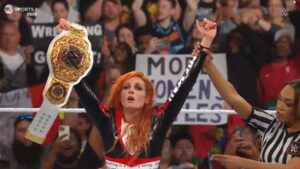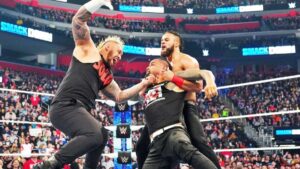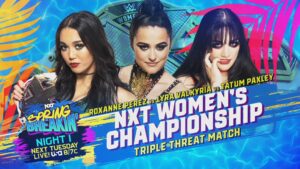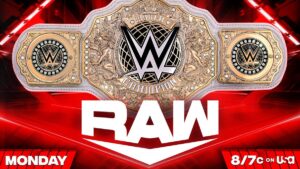All Elite Wrestling (AEW) is set to become the next major US wrestling promotion to enter the fray, when the debut on PPV on May 25, 2019, from Las Vegas, Nevada with Double or Nothing. With a strong financial backing, a solid and talented core of administrative people behind the scenes, and the start of a roster that is immediately competitive, AEW is looking to provide another alternative to wrestling fans in 2019. While it’s become too distant a race for anyone to become “competition” for the WWE – they’re global brand is too far ingrained in the collective zeitgeist of the world as far as professional wrestling is concerned – AEW, along with the likes of IMPACT Wrestling, Ring of Honor, Major League Wrestling, and others can still have their niche audience and provided an alternative product to those who are disenfranchised with the WWE these days.
#AEW #DoubleOrNothing Sat, May 25th #LasVegas #SoldOut#YOUNGBUCKSvsLUCHABROS@MattJackson13 & @NickJacksonYB vs @PentaElZeroM & @ReyFenixMx pic.twitter.com/eI78pfHG3V
— All Elite Wrestling (@AEW) March 11, 2019
Think of it like comparing smaller studios to Disney. No one in this day and age has the financial or ingrained history of Disney to compare to the multi-billion dollar empire it’s become – and as it acquires franchises and properties, from The Muppets to Marvel Comics to Star Wars (and now FOX Studios), that empire will only continue to expand. But that doesn’t mean that other film studios can’t still put out quality films that provide entertainment value equally as good as that of Disney.
#AEW #DoubleOrNothing Sat, May 25th #LasVegas#HANGMANvsBASTARD@theAdamPage vs @BastardPAC pic.twitter.com/fiC6tKusGZ
— All Elite Wrestling (@AEW) March 7, 2019
So now AEW prepares for its debut PPV, it’s launching point before it breaks into the TV market. They’ve already trademarked Tuesday Night Dynamite as a name for a show, looking at a Tuesday night time slot to fill the gap left by WWE’s SmackDown Live heading to Friday nights on FOX this fall, and by all reports, AEW is looking to launch Tuesday Night Dynamite around the same time. Reports also state that AEW is much closer to signing a TV deal than most think and that it’s literally in AEW’s court as to which of the potential two or three suitors best fits (and will support) their vision – as of now, the front runner appears to be TBS.
#AEW #DoubleOrNothing Sat, May 25th #LasVegas#ALPHAvsOMEGA2@IamJericho vs @KennyOmegamanX pic.twitter.com/EpiwZFO2L9
— All Elite Wrestling (@AEW) March 6, 2019
So how does Double or Nothing, at least the card and PPV as we know of as of writing, compare to the inaugural PPV shows for every major US wrestling promotion since the advent of Pay Per View in the early 1980s (starting with Closed Circuit Television)? How have their cards measured up? How has their attendance been? Let’s look at the cards and story behind every major US promotions first PPV endeavour and compare it to AEW’s upcoming debut.
DISCLAIMER: For the intent and purposes of this article, CCTV events (such as NWA’s Starrcade and WWE’s WrestleMania) are included as they were the early proponent to PPV; Dark Matches for any event are not listed for comparison purposes, as these matches were not seen by the initial viewing audience.
AWA – Super Sunday, April 24, 1983

St. Paul Civic Center, St. Paul, Minnesota, Attendance: 20,000
- Brad Rheingans vs. Rocky Stone
- Buck Zumhoffe vs. Steve Regal
- Jerry “The King” Lawler vs. John Tolos
- NWA World Women’s Tag Team Championship: Joyce Grable & Wendi Richter (c) vs. Judy Martin & Velvet McIntyre
- Wahoo McDaniel vs. Eddie Boulder (Brutus Beefcake)
- Jesse Ventura & The Heenan Family (Ken Patera & Blackjack Lanza) (w/ Bobby Heenan) vs. Rick Martel & The High Flyers (Jim Brunzell, & Greg Gagne)
- AWA World Championship: Nick Bockwinkel (c) (w/ Bobby Heenan) vs. Hulk Hogan
- Verne Gagne & Mad Dog Vachon vs. Jerry Blackwell & Sheik Adnan Al-Kaissie
It was Verne Gagne‘s American Wrestling Association (AWA) that started the SuperCards on CCTV with Super Sunday in the spring of 1983. But while it came out strong, with a solid attendance of 20,000 (still the largest crowd for a debut major CCTV/PPV SuperCard), it would be one of the final major feathers in the cap for Verne and the AWA. On over-reliance on CCTV, as PPV began to emerge in the mid-80s, AWA wouldn’t hold their first PPV until 1989. An increasing PPV demographic that simply stopped attending CCTV events and Verne’s tardiness in embracing cable television lead to AWA having to merge with Fritz Von Erich‘s World Class Championship Wrestling (WCCW) and Jerry Lawler & Jerry Jarrett‘s Continental Wrestling Association (CWA) in the late 80s to avoid demise. AWA pulled out early into the merger (with the other two rebranding as the USWA), but by the early 1990s, AWA was defunct. Like many early SuperCards, AWA relied on a top-heavy event, with Nick Bockwinkel fending off a hot young star named Hulk Hogan (Gagne’s reluctance to put that belt on Hogan lead to him jumping back to the WWF the following year), and Verne Gagne came out of retirement to main event the show over his own World Champion.
NWA – Starrcade, November 24, 1983

Greensboro Coliseum, Greensboro, North Carolina, Attendance: 15,447
- The Assassins (Assassin #1 & Assassin #2) (w/ Paul Jones) vs. Rufus R. Jones & Bugsy McGraw
- Kevin Sullivan & Mark Lewin (w/ Gary Hart) vs. Scott McGhee & Johnny Weaver
- Abdullah the Butcher vs. Carlos Colon
- Cowboy “Ace” Bob Orton Jr. & Dick Slater vs. Mark Youngblood & Wahoo McDaniel
- NWA TV Championship (Title vs Mask): Great Kabuki (w/ Gary Hart) (c) vs. Charlie Brown
- Dog Collar Match: Roddy Piper vs Greg Valentine
- NWA Tag Team Championship: Brisco Brothers (Jack & Jerry Brisco) (c) vs. Ricky Steamboat & Jay Youngblood
- NWA World Championship, Steel Cage: Harley Race (c) vs. Ric Flair
The National Wrestling Alliance (NWA) relied heavily on Closed Circuit Television for its first several events, with Starrcade ’87 being their first jump into actual PPV television (two years after WWF had already begun to utilize the new service). But Starrcade ’83 was their first major launch into the SuperCard business and CCTV (and actually did better than ’87, which was held at the UIC Pavillion in Chicago, and only drew 8,000 in attendance). While the top three matches of the card are still historically significant matches, particularly the Steel Cage match that saw Harley Race essentially pass the torch to Ric Flair as the new face of the NWA for the 1980s), the rest of the card was somewhat underwhelming in hindsight. Some regional feuds and filler matches, it was clearly built around the top three matches. Lucky for them, they were three immensely huge marquee matches. Many Roddy Piper fans consider this brutal dog collar match against Greg “The Hammer” Valentine as one of the Rowdy Scot’s defining moments. A solid crowd of 15,000+ on hand at the legendary Greensboro Coliseum, a stacked top of the card, has made Starrcade ’83 a landmark in professional wrestling, despite a somewhat lacklustre undercard for the most part.
WWE – WrestleMania I, March 31, 1985

Madison Square Garden, New York City, Attendance: 19,121
- Tito Santana vs. The Executioner (Buddy Rose)
- King Kong Bundy (w/ Jimmy Hart) vs. SD Jones
- Ricky Steamboat vs Matt Borne
- Brutus Beefcake (w/ Luscious Johnny Valiant) vs David Sammartino (w/ Bruno Sammartino)
- WWF Intercontinental Championship: Greg “The Hammer” Valentine (w/ Jimmy Hart) vs. Junkyard Dog
- WWF Tag Team Championship: US Express (Barry Windham & Mike Rotunda) (w/ Captain Lou Albano) (c) vs. Iron Sheik & Nikolai Volkoff (w/ Classy Freddie Blassie)
- Andre the Giant vs. Big John Studd (w/ Bobby Heenan)
- WWF Women’s Championship: Leilani Kai (w/ Fabulous Moolah) (c) vs. Wendi Richter (w/ Cyndi Lauper)
- Hulk Hogan & Mr. T (w/ “Superfly” Jimmy Snuka) vs. Rowdy Roddy Piper & Paul Orndorff (w/ Cowboy “Ace” Bob Orton Jr.)
While people constantly compare WrestleMania cards year after year, comparing matches and full cards, WrestleMania I seems to get a free pass on most lists simply because it was the event that launched a pro wrestling tradition and the benchmark for SuperCards in the US. But much like NWA’s Starrcade launch two years prior, it was heavily built around the top three matches – arguably, it was actually just the top two. Cyndi Lauper‘s involvement with the WWE in 1984 and 1985 had a major impact on WWF entering the mainstream, as her participation tied the WWF with new music channel MTV and a new younger demographic. At one point, Wendi Richter was actually outdrawing Hulk Hogan, albeit it early in the stages of Hulkamania. But by the end of WrestleMania I, Hulk Hogan was cemented as the biggest wrestling MegaStar on the planet. But like Starrcade ’83, the undercard was largely underwhelming. Also, in future debates about the worst WrestleMania match of all time, the answer is Brutus Beefcake vs. David Sammartino, hands down. Beefcake was always better with better opponents, and the wrestling ability fell so far from the tree for David Sammartino, that he may as well have tried his hand at brain surgery. But over 19,000 people filled Madison Square Garden that night and WWF became the biggest name in pro wrestling after that, a feat that has rarely been challenged. Of course, WWF’s first actual PPV was that fall’s Wrestling Classic, which first properly introduced “Macho Man” Randy Savage and the British Bulldogs to the WWF Universe on a wide scale.
WCW – WrestleWar: WarGames, February 24, 1991

Arizona Veterans Memorial Coliseum, Phoenix, Arizona, Attendance: 6,800
- WCW 6-Man Tag Team Championship: Ricky Morton, Tommy Rich & Junkyard Dog (c) vs The State Patrol (Curtis Hughes, Lt. James Earl Wright & Sgt. Buddy Lee Parker)
- Bobby Eaton vs Brad Armstrong
- Itsuki Yamazaki & Mami Kitamura vs Miki Hanada & Dynamite Kinsai
- Dustin Rhodes vs. Buddy Landell
- Young Pistols (Steve Armstrong & Tracy Smothers) vs. The Royal Family (Jack Victory & Rip Morgan)
- Terry Taylor (w/ Alexandra York (Terri Runnels)) vs “The Z-Man” Tom Zenk
- Vader vs. Stan Hansen
- WCW US Championship: Lex Luger (c) vs Danny Spivey
- WCW World Tag Team Championship: Doom (Butch Reed & Ron Simmons) (w/ Teddy Long) (c) vs. The Fabulous Freebirds (Michael PS Hayes & Jimmy Garvin) (w/ Diamond Dallas Page & Oliver Humperdink)
- War Games: Four Horsemen (Ric Flair, Barry Windham & Sid Vicious) & Larry Zybysko (w/ Arn Anderson) vs. The Steiner Brothers (Rick & Scott Steiner), Sting & Brian Pillman
In 1988, Jim Crockett Promotions (JCP), the company that now owned NWA Mid Atlantic, Mid South Wrestling, Championship Wrestling From Florida and other NWA territories, went under, forcing JCP to sell their entire company to billionaire Ted Turner. Initially, his new venture, redubbed World Championship Wrestling (WCW), remained under the NWA banner, but in 1991, WCW held it’s first PPV under the WCW banner. It was the third annual WrestleWar PPV, but the first under WCW’s name. Again, the tradition of building the card up from the bottom meant that the undercard was again not much of a focal point. It wasn’t until the Japanese showcase match of Vader vs Stan Hansen that the action got memorable, but it proved one thing beyond a shadow of a doubt. While they may have had a lot of the carryover NWA stars from the 1970s and 1980s still working for them, they were still trying to find their identity. Going from over 15,000 for NWA’s Starrcade just eight years earlier to struggling to hit 7,000 for their first lone WCW endeavour – even with Ric Flair on the card – showed that confidence in this new “NWA” wasn’t exactly earned yet.
ECW – Barely Legal, April 13, 1997

ECW Arena (now 2300 Arena), Philadelphia, Pennsylvania, Attendance: 1,170
- ECW Tag Team Championship: The Dudley Boyz (Bubba Ray & Devon Dudley) (w/ Joel Gertner & Sign Guy Dudley) (c) vs. The Eliminators (John Kronus & Perry Saturn)
- Rob Van Dam vs. Lance Storm
- Great Sasuke, Gran Hamada & Masato Yakushiji vs. bWo Japan (Taka Michinoku, Men’s Teoh & Dick Togo)
- ECW TV Championship: Shane Douglas (w/ Francine) (c) vs. Pitbull #2
- Taz vs. Sabu
- #1 Contenders Triple Threat: Terry Funk vs Sandman vs. Stevie Richards
- ECW World Championship: Raven (c) vs. Terry Funk
When WCW officially withdrew itself from the NWA in 1993, it left Eastern Championship Wrestling (ECW) from Philadelphia as it’s largest visible territory left. But even that didn’t last. Shortly after they held a tournament to crown a new NWA World’s Heavyweight Champion, ECW’s Shane Douglas (who had won the title), immediately threw it down and declared ECW was also seceding from the NWA and was rebranding as Extreme Championship Wrestling (ECW). ECW held multiple events and SuperCards in its earliest days, but it wasn’t until 1997 that they first entered the world of live PPVs with Barely Legal. Unlike past attempts at PPVs, as we’ve just seen, ECW bucked the trend of having a subpar undercard just to have a more thunderous top heavy card. From the opening match of The Dudley Boyz vs The Eliminators for the ECW World Tag Team titles to the closing mayhem of Raven vs Terry Funk for the ECW World Heavyweight Championship, ECW threw together a fast-paced, exciting card from top to bottom. The only problem was that ECW had limited TV exposure and remained a mostly underground promotion.
TNA – Victory Road, November 7, 2004

TNA Impact Zone, Orlando, Florida, Attendance: 700
- X-Division Cup Gauntlet Match: Frankie Kazarian vs. Sonjay Dutt vs. Puma (TJ Perkins) vs. LA Park vs. Jerrelle Clark vs. Kazushi Miyamoto vs. Michael Shane (Michael Bentley) vs. Hector Garza vs. Nosawa Rongai vs. Mikey Batts vs. Alex Shelley vs. Matt Sydal vs. Sonny Siaki vs. Jason Cross vs. Shark Boy vs. Psicosis vs. D-Ray 3000 vs. Amazing Red vs. Spanky (Brian Kendrick) vs. Chris Sabin
- Ron Killings (R-Truth), Erik Watts, Johnny B. Badd (Marc Mero) & Pat Kenney (Simon Diamond) vs. The Naturals (Andy Douglas & Chase Stevens), Kid Kash & Dallas (Lance Archer)
- Mascarita Sagrada vs. Piratita Morgan
- NWA Tag Team Championship: Team Canada (Eric Young & Bobby Roode) (c) vs. 3Live Kru (BG James (Road Dogg) & Konnan)
- Trinity (w/ Johnny Swinger & Glenn Gilberti (Disco Inferno)) vs. Jacqueline
- Monster’s Ball: Monty Brown vs. Raven vs. Abyss
- TNA X-Division Championship: Petey Williams (c) vs. AJ Styles
- Elimination Last Team Standing Match: America’s Most Wanted (James Storm & Chris Harris) vs. Triple X (Christopher Daniels & Elix Skipper)
- NWA World Championship Ladder Match: Jeff Jarrett (c) vs Jeff Hardy
Following the demise of both WCW and ECW, Jeff Jarrett and his father, Jerry, launched Total Nonstop Action (TNA) Wrestling in 2002. For it’s first few years it relied on weekly 2-hour PPV shows, but these were just PPV versions of the TV show that would ultimately become Impact Wrestling (and later the impetus for its current brand name, IMPACT Wrestling). In 2004, they held their first monthly, 3-hour PPV event, with Victory Road, that in hindsight, was a pretty solid endeavour. The opening match of the 20-man X-Division Cup gauntlet match features a who’s who of indie pioneers of the early 2000s, many of whom are still wrestling today. Fast-paced action and showcasing some of the smaller stars that WWE was avoiding at the time – such as a young AJ Styles – it was headlined by Jeff Jarrett defending his NWA World’s title against Jeff Hardy, who had only debuted in TNA months earlier after leaving WWE in late 2003. But after two years of operation, TNA was reluctant to move outside of their usual TV taping home, the Impact Zone in Orlando, Florida, so it was only seen by a live attendance of approximately 700 people.
ROH – Final Battle, December 19, 2009

Manhattan Center, New York City, Attendance: 1,300
- Four Corner Survival Match: Claudio Castagnoli (Cesaro) (w/ Prince Nana & Mr. Ernesto Osiris) vs Colt Cabana vs. Kenny Omega vs. Rhett Titus
- The Embassy (Bison Smith & Erick Stevens) (w/ Prince Nana & Mr. Ernesto Osiris) vs. Bobby Dempsey & Delirious (w/ Daizee Haze)
- Eddie Kingston vs Chris Hero (w/ Sara Del Rey & Shane Hagadorn)
- The Young Bucks (Matt & Nick Jackson) vs. Kevin Steen (Kevin Owens) & El Generico (Sami Zayn)
- Kenny King vs Roderick Strong
- Rocky Romero vs Alex Koslov
- ROH Tag Team Championship: American Wolves (Davey Richards & Eddie Edwards) (w/ Shane Hagadorn) (c) vs. The Briscoes (Jay & Mark Briscoe)
- Jack Evans vs Teddy Hart
- ROH World Championship: Austin Aries (c) vs. Tyler Black (Seth Rollins)
Much like ECW in the 1990s, Ring of Honor took several years before they entered the live PPV service. Founded in 2002, ROH would rely on live events and DVD sales for their major events. But in 2009, the launched their foray into live PPVs with the seventh annual Final Battle card, which featured a who’s who of many of today’s top superstars, including Seth Rollins, Kenny Omega, The Young Bucks, Kevin Owens, Roderick Strong, Austin Aries, Colt Cabana, and more. A stellar card from top to bottom, it is a perfect time capsule of the best of the US indie scene at the end of the 2000s. But even after seven years of operation, the best ROH could do for a live attendance was 1,300 people at the Manhattan Center in New York City.
AEW – Double or Nothing, May 25, 2019

MGM Grand Garden Arena, Paradise, Nevada, Attendance: 14,000
- Over The Budget Battle Royal: Sonny Kiss vs Kip Sabian vs. Brandon Cutler vs. Ace Romero vs. TBA
- Britt Baker vs Nyla Rose vs. Kylie Rae
- SCU (Christopher Daniels, Frankie Kazarian & Scorpio Sky) vs. CIMA + TBD (two unnamed wrestlers from China’s OWE)
- Cody vs. TBA
- “Hangman” Adam Page vs PAC
- Kenny Omega vs Chris Jericho
- The Young Bucks (Matt & Nick Jackson) vs. The Lucha Brothers (Pentagon Jr. & Fenix)
While some might argue that All In should count as AEW’s inaugural PPV, it’s worth pointing out that while three of the same players – Cody and the Young Bucks – were the creative team for All In, it was presented more like an all-inclusive cross-promotional SuperCard. There were talents from ROH, NJPW, IMPACT Wrestling, NWA, and more involved, and the same line-up would not be doable under the AEW banner. But Double or Nothing is the first true representation of what AEW as a company will be putting forth going forward and is a better indication of the company’s mission statement. With barely a match announced for the event, they managed to sell out 14,000 tickets for the PPV’s live audience, making it the third highest PPV debut behind the AWA, WWF and NWA. The format is more akin to the newer entrants in the list, like ECW, TNA and ROH, in that they’re looking for a card built from top to bottom, rather than relying in the main events as the crux of the action – although the top three matches (so far) certainly warrant some big headlines. We’re still a month or so away from knowing the entire card for Double or Nothing, but so far it’s on pace to be one of the better PPV debuts in the US, which hopefully means that they’re in for a healthy lifespan as an exciting new alternative to WWE’s product around the world.
Stay tuned to the Last Word on Pro Wrestling for more on this and other stories from around the world of wrestling, as they develop. You can always count on LWOPW to be on top of the major news in the wrestling world, as well as to provide you with analysis, previews, videos, interviews, and editorials on the wrestling world.






